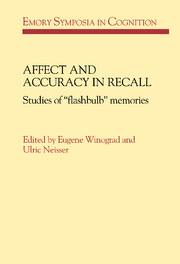Book contents
- Frontmatter
- Contents
- Preface
- List of contributors
- 1 Introduction
- Part I Empirical studies
- Part II Developmental studies
- Part III Emotion and memory
- Part IV Theoretical issues
- 11 Special versus ordinary memory mechanisms in the genesis of flashbulb memories
- 12 Remembering personal circumstances: A functional analysis
- 13 Constraints on memory
- 14 The theoretical and empirical status of the flashbulb memory hypothesis
- Author index
- Subject index
11 - Special versus ordinary memory mechanisms in the genesis of flashbulb memories
Published online by Cambridge University Press: 22 March 2010
- Frontmatter
- Contents
- Preface
- List of contributors
- 1 Introduction
- Part I Empirical studies
- Part II Developmental studies
- Part III Emotion and memory
- Part IV Theoretical issues
- 11 Special versus ordinary memory mechanisms in the genesis of flashbulb memories
- 12 Remembering personal circumstances: A functional analysis
- 13 Constraints on memory
- 14 The theoretical and empirical status of the flashbulb memory hypothesis
- Author index
- Subject index
Summary
The chapters in this volume, as well as the discussions at the conference from which the volume emerged, illustrate clearly that the study of “flashbulb” memories raises a wide variety of difficult and often controversial issues. In commenting on the chapters by Larsen (this volume) and Neisser and Harsch (this volume), however, I will focus primarily on a single question: What are the implications of these studies for the hypothesis of a special flashbulb memory mechanism?
The special-mechanism hypothesis
The special-mechanism hypothesis has dominated flashbulb memory research since Brown and Kulik's 1977 article. Larsen addresses this hypothesis directly in his chapter; and although Neisser and Harsch do not couch their discussion in terms of the special-mechanism hypothesis, the data they present are certain to figure prominently in any future discussions of the hypothesis.
The Larsen study and the Neisser and Harsch study report data that will be, and I think should be, taken as evidence against the special-mechanism hypothesis. However, both studies may attract an objection that has been raised against previous critiques of the special-mechanism hypothesis. Specifically, the objection may be that neither the Larsen study nor the Neisser and Harsch study definitively refutes the special-mechanism hypothesis, because neither study demonstrates clearly that ordinary memory mechanisms are sufficient to account for flashbulb memories. This objection deserves careful attention, because it is entirely valid, but at the same time entirely ineffective as a defense of the special-mechanism hypothesis.
- Type
- Chapter
- Information
- Affect and Accuracy in RecallStudies of 'Flashbulb' Memories, pp. 227 - 235Publisher: Cambridge University PressPrint publication year: 1992
- 9
- Cited by



